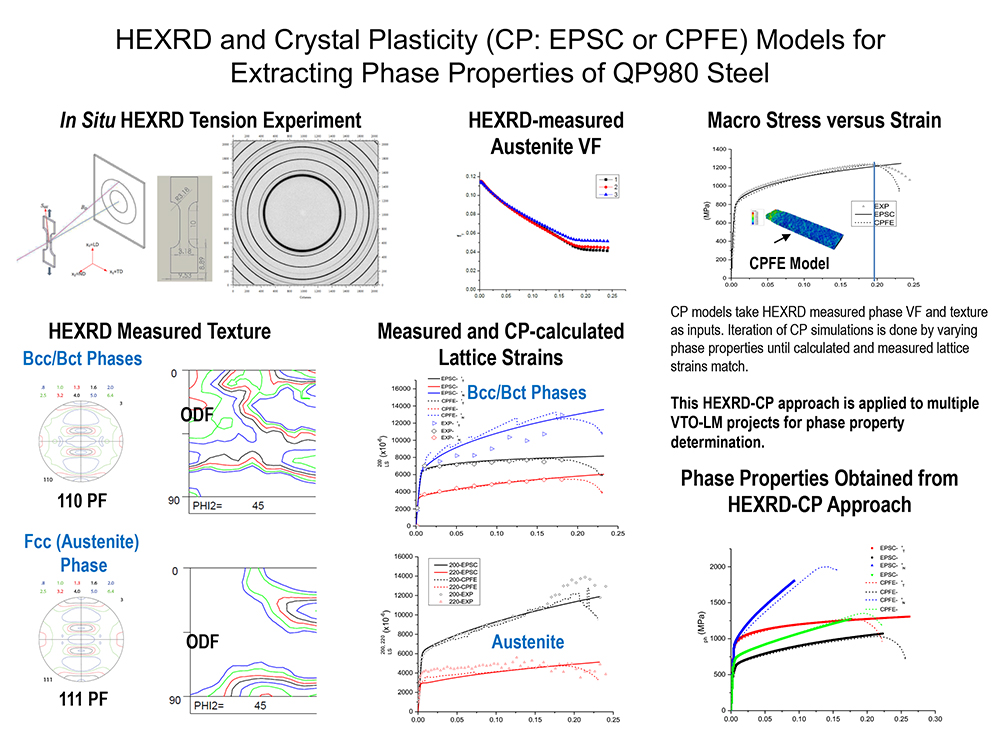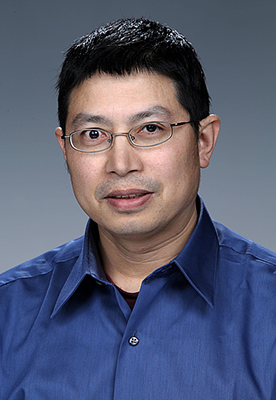Advanced Computing, Mathematics and Data
Research Highlights
June 2017
A Steely Combination
DOE labs and industry team unveil new predictive modeling method
Examining steel strength and forming behaviors to fully evaluate overall performance requires increasingly accurate predictive models. Recently, Xiaohua Hu, a scientist with the Advanced Computing, Mathematics, and Data Division’s Computational Engineering group, along with researchers from General Motors and Argonne National Laboratory, coupled experimental high-energy synchrotron X-ray diffraction, or HEXRD, and modeling approaches to examine the critical-resolved shear stresses and hardening parameters of constituent phases in a TRIP-assisted steel. “Transformation-induced plasticity” (hence, TRIP) steels are used by the automotive industry because of their distinct strength and ductility (how the material deforms under stress).
 The team’s HEXRD process at work. Enlarge Image.
The team’s HEXRD process at work. Enlarge Image.
The resulting paper, “Individual Phase Constitutive Properties of a TRIP-assisted QP980 Steel from a Combined Synchrotron X-ray Diffraction and Crystal Plasticity Approach,” was published in Acta Materialia, a journal devoted to advancing the understanding of the structure and properties of inorganic materials. The team’s experimental/theoretical method involved using combined crystal plasticity models, including the elastoplastic self-consistent (EPSC) and crystal plasticity finite element (CPFE) models. Specifically, their study focused on combining HEXRD and plasticity models to determine the slip system parameters and average stress versus strain relationships for individual phases of QP980, a commercial third-generation advanced high-strength steel. These materials, known as 3GAHSS, are considered elemental in the automotive industry’s ongoing efforts to improve fuel economy using lightweight steel without compromising vehicle safety.
After acquiring the HEXRD data collected at Argonne’s Advanced Photon Source user facility, Hu and his team input the data into a computationally efficient EPSC model to collect constitutive parameters of different slip systems, which then were fed to the CPFE model representing the QP980 tensile sample. When compared with experimental results, their new technique yielded good predictions in terms of macroscopic stress-strain curves and lattice distortion. It also afforded a solid comparison of EPSC- and CPFE-based results, indicating that the EPSC calculation was more computationally efficient.

Xiaohua Hu served as primary author of the paper featured in Acta Materialia.
“Improving future 3GAHSS means that we must be able to assess their properties at individual phases and multiple scales to uncover how effects like strain really impact forming and performance,” Hu explained. “Because experimental results can only go so far, simulation methods, built from increasingly accurate evaluations of materials properties, will be the primary way to fully understand how microstructural-level responses might affect actual in-service performance.”
Notably, this work represents a distinct partnership between DOE national laboratories and industry that supports application standardization efforts as part of the Integrated Computational Materials Engineering (ICME) multiscale approach.
Research Team: Xiaohua Hu (PNNL); Yang Ren, from Argonne National Laboratory’s X-ray Science Division; Louis Hector Jr., of General Motors Research and Development; and Xin Sun, previously with PNNL now at Oak Ridge National Laboratory.
Acknowledgment
The Department of Energy’s National Energy Technology Laboratory supported this work.
Reference
Hu XH, X Sun, LG Hector Jr., and Y Ren. 2017. “Individual phase constitutive properties of a TRIP-assisted QP980 steel from a combined synchrotron X-ray diffraction and crystal plasticity approach.” Acta Materialia (132):230-244. DOI: 10.1016/j.actamat.2017.04.028.
